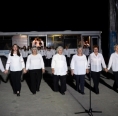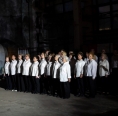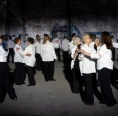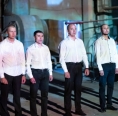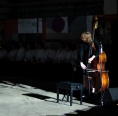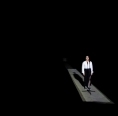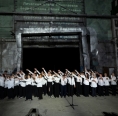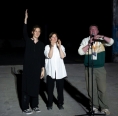-
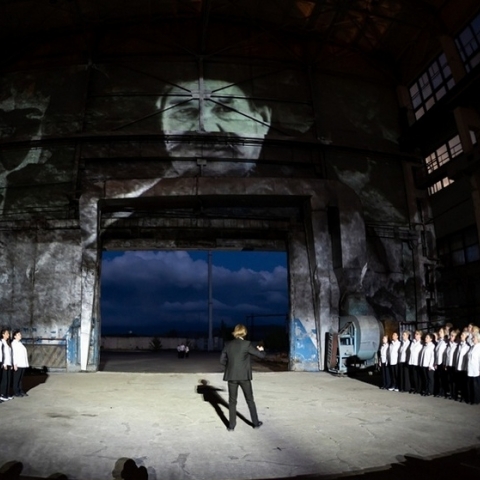
LEDGES
-
Address:
-
Partners:
Audiovisual performance “Ledges” premiered on July 17 was an impression, a wonder, and even a shock. Angar Art Space (former garage of BelAZ trucks) was chosen as the place to show the innovative theatrical project created by the Theater of City Residents directed by Ivan Minevtsev.
On the eve of the show, we have already told the story of the unusual modern theatrical art project as viewed by a professional. Today we will try to show it as perceived by the spectators and participants.
The premiere was deliberately scheduled for a late evening. Just when it got dark, the spectators took their seats, the garage lights went down, and the acting space was opened. On the left, a part of a huge “box” made of concrete and iron was lit up with the blue night, which was to set in, faintly gleaming into the windows; on the right, the dusk lights faded away. In the center, a wall with sliding doors, which were used as a massive mechanical stage curtain, turned into a big cinema screen.
“The story we are going to tell you lasts for almost one hundred years. It is a story of one labor dynasty. The text, you will hear, is a playwriter’s fancy. The facts mentioned in the text are real. All the characters are not fictional, coincidences are not accidental”. This text, which appeared on the screen in parts on the background of quarry ledges and shrilly dribbling metal sounds, started the action. It was clear from the very beginning — the spectators will face somewhat incredible.
All the sounds and visuals in this performance became one of the main effects and served as a hyperbole, making the memories of the workers from Magnezit even more expressive and the parts of the mechanisms and rocks enlarged to а great extent almost tangible. The “full-immersion effect” was reached. Video frames continued changing on the screen; and after the inscription “Episode 1. Efim Kuzmich. 1874”, a soft and calm male voice said, as if it was a gramophone record:
“We dwelt in the suburbs of Ryazan. Maksimovka Village, Sapozhkovskiy District. We had a house. How can such a big family be without a house? Six children! We had a small land plot to grow food. And a horse. That was the reason to decide that we had cattle, therefore we were prosperous, and we were to be deprived of our possessions as kulaks. We did not really manage to pack our staff. Some documents only, and a couple of things. We just grabbed our children and took a train. When you have no idea where you go, it is the longest road. I saw the nature changing. It became such a … as if it occupied more space and became greater. I just heard the driver's voice: “Satka! Get off”… That was the place, where our family had to start from scratch. We lived in a barrack hut consisting of two rooms. There were no walls there, only fabric partitions instead of them. Few meters were to accommodate ten people. It was hard in the beginning. Children, a new place, and no possessions at all. I thought that time: there were two ways for me – to live in hatred for the things done to my family or to forget it and start the new life. I chose working at a plant. My son Nikifor joined me. We both worked as furnace chargers… So we started little by little”.
The story of Efim Navolokin, who arrived into Satka in the middle of the past century, was continued by his descendants (today the total length of service of this dynasty is more than 800 years). We could only hear the voice of Efim Kuzmich, but managed to see his son Nikifor – modern technologies revived his photo on the screen. As a result, were were told the story of six generations in one family. It involved not only storytellers and spectators, but also the choir — one of the main characters in the performance.
It appeared in the beginning of the second episode. When the sounds from production workshops and the music, which was written specially for the performance and played by art band “Waldgang” gradually drew louder, the curtains revealed a big singing group. Their snowy blouses and shirts seemed to cut up the suppressing dark space. The singers accompanied all the following episodes. The choir assembled all seemingly scattered sounds: workshop noises (ringing and groaning metal, shrieks, rattle, etc.), melodies and sound effects produced by musical instruments (Angar itself became a musical instrument, hitting it with iron elements was the dominant of the episode involving the male part of the choir), singing and talking voices, applause, and even whisper in the hall. The choir was the main “pin” of the performance.
In the final scene, opera singer Tatiana Bikmukhametova — a representative of the Navolokiny dynasty — joined the singers. At first her amazing voice “flew over” the hall: the young woman appeared behind the stands on a “balcony”, which was a former grounding area for a travelling crane. And then she effectively appeared before the audience walking down a bright white road caught by a searchlight and singing an aria in German about the most important things for every family: home and happiness.
A video of the performance can be viewed at the link.
Source: Magnezitovets. Photo by: Vasily Maksimov
-
26.08 - 26.08
DIARY OF THE THIRD INDUSTRIAL BIENNALE
-
28.11 - 28.11
MY SATKA FESTIVAL WINS THE CONTEST OF CORPORATE VOLUNTEER PROJECTS
-
13.10 - 15.10
COOPERATION WITH VGIBL NAMED AFTER M.I. RUDOMINO

